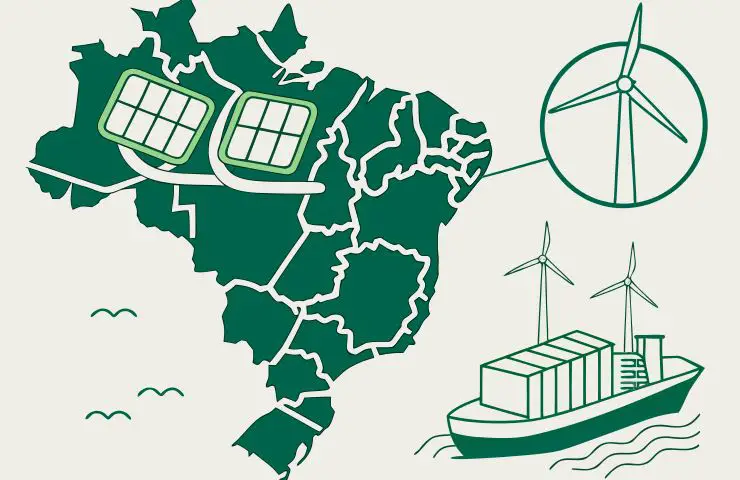
Green Hydrogen Development in Brazil: Major Projects Advance Amid Regulatory Uncertainty
October 28, 2025Brazil’s green hydrogen ambitions are picking up steam like never before—over 100 projects and a whopping US$80 billion in pledges are now on the table. The federal Ministry of Mines and Energy (MME) just narrowed its inaugural hydrogen hub auction to 12 powerhouse consortia, including CSN Group, EDP Renováveis, Petrobras and Eletrobras. Down in Ceará, Companhia de Desenvolvimento do Complexo Industrial e Portuário do Pecém (CIPP) and the state government—backed by the World Bank—are racing to fire up pilot electrolyzer facilities at the Pecém Industrial and Port Complex. Still, with Brazil’s hydrogen regulatory framework up in the air, many warn that this uncertainty could slow financing, spook investors and chip away at the country’s first-mover advantage in green hydrogen, hydrogen production and cutting-edge sustainable energy.
Key takeaways
- More than 100 green hydrogen projects need roughly 90 GW of new renewable capacity.
- MME’s 2025 hydrogen hub call includes big names like CSN Group, Petrobras and Eletrobras.
- State-level drives in Ceará (Pecém) and Rio de Janeiro (Port of Açu) lean on the World Bank and other multilateral backers.
- Regulatory delays—grid access, certifications, permits—are investors’ top headache.
- Opportunities span green ammonia, green steel and e-methanol for export and domestic industrial decarbonization.
Historical and strategic context
Ever since unveiling its National Hydrogen Strategy in 2021 and passing the Hydrogen Act 2024, Brazil has made it crystal clear: it wants to leverage its massive hydropower, wind and solar fleets for large-scale hydrogen production. The Act lays out auction rounds from 2028 to 2032 and throws in an R$18.3 billion tax credit to sweeten the deal. It’s a logical next step after a decade where hydropower jumped to over 60% of the grid, and wind plus solar raced past 30 GW—fueling a nationwide push toward sustainable energy.
Technical backbone and project scale
At the heart of all this is green hydrogen made via electrolysis—you run renewable electricity through water (H2O), split it into hydrogen (H2) and oxygen (O2), and voilà: zero direct emissions. Early movers at Pecém are eyeing 500 MW-class electrolyzers by 2027, then scaling up to gigawatt-scale plants. The plan? Feed that H2 into:
- Green ammonia—for fertilizers or maritime fuel.
- Green steel—using hydrogen-based direct reduced iron.
- E-methanol—a shipping fuel and chemical feedstock.
Meanwhile, at the Port of Açu in Rio de Janeiro, developers like Prumo Logística are mapping out integrated hydrogen-to-export chains, taking full advantage of deepwater berths and existing hydrogen infrastructure.
Financing, policy and partnerships
Cash is coming in layers: the World Bank has pledged US$153 million to Ceará’s hydrogen roadmap, and the Climate Investment Funds plus the EU’s Global Gateway are pitching in with technical and financial muscle. On top of that, federal tax breaks and state-level concessions on land and infrastructure fees make the economics even sweeter. But here’s the rub: the playbook on grid access charges, certificate schemes and permit timelines is still a bit hazy. That’s why some of the biggest bidders are playing it cool, holding off final investment decisions until the rules of the game are crystal clear.
When MME named its 12 finalists in January 2025—including Neoenergia, Cemig and Solatio Holding Solar—it was a big milestone. Now these consortia are haggling over offtake agreements and locking down financing. Yet many have publicly said they won’t give the green light until they see detailed regulations in black and white.
Subnational momentum
Beyond Ceará and Rio, at least five other states—Bahia, Rio Grande do Sul, Paraná, Minas Gerais and Espírito Santo—are cooking up their own hydrogen roadmaps. You’ve got pilot plants, research partnerships at state universities and fast-track licensing windows. It’s exciting, but you’ve also got a patchwork of rules that could lead to headaches if the feds don’t roll out a unified framework soon.
Economic and social impacts
Big green hydrogen rollouts aren’t just about clean energy—they’re about jobs and communities too. Ceará’s government expects to create over 10,000 new jobs across construction, operations and maintenance, with training programs lined up to certify 800 technicians and engineers by 2026. Building out supply chains and transferring cutting-edge know-how can seriously boost regional economies. Of course, there’s a flip side: you’ve got to manage land use, water sourcing and community engagement carefully to make sure growth stays sustainable.
Regulatory uncertainty: the central barrier
Everyone agrees on one thing: murky rules around grid connections, wheeling fees, “green” molecule certifications and environmental permits are the biggest showstopper. Without standardized offtake frameworks or clear auction mechanisms, banks and offtakers can’t price risk—and that uncertainty could slip project timelines by 12–18 months, insiders warn.
Global competition and export outlook
Out there in the world, demand for green hydrogen and its derivatives is shooting up—Europe aims to import 10 Mt by 2030, and Asia’s busy chasing its own decarbonization targets. Brazil’s cost edge—roughly US$1.50–2.00 per kg of hydrogen—comes from its abundant renewables and low production costs. But rivals in Australia, the Middle East and North Africa aren’t standing still. Seizing global market share hinges on:
- Timely rollout of the Hydrogen Act regulations.
- Synced grid expansions aligned with hydrogen project timelines.
- Clear export protocols and smart trade deals.
Next steps
- Fast-track the Hydrogen Act’s implementing regulations by mid-2026.
- Standardize grid access rules and green certification processes.
- Streamline environmental and water-use permits at key hubs.
- Boost coordination between federal, state and multilateral players.
- Set up a national green hydrogen certification authority.
At the end of the day, Brazil’s green hydrogen story is at a make-or-break moment. The policy commitments and financial pledges are on the books, but without clear, bankable rules, the momentum could stall just as global competition heats up. The next 12 months will really show if Brazil can cement its role as a hydrogen powerhouse and drive real industrial decarbonization.


 With over 15 years of reporting hydrogen news, we are your premier source for the latest updates and insights in hydrogen and renewable energy.
With over 15 years of reporting hydrogen news, we are your premier source for the latest updates and insights in hydrogen and renewable energy.